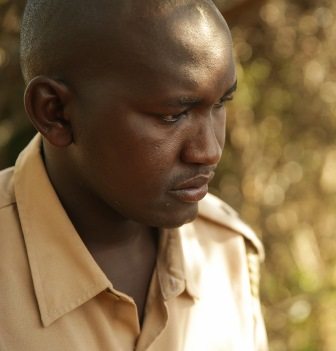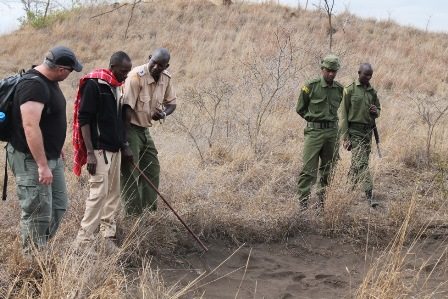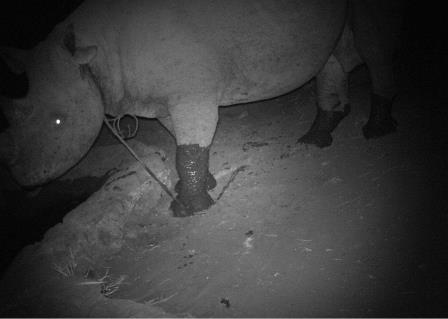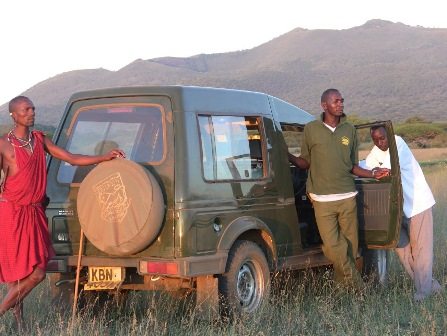
Can you please introduce yourself to me and tell me how long you have been working as a ranger for Big Life?
I am currently the head of the Big Life rhino programmes. I started working for Big Life in 2003. I started as a very, very young junior ranger, when I started with Big Life I was the youngest ranger in a team of 15. At that time, I was 17 years old.
How big is the area that you patrol?
It is over 200km square – so a pretty big area! It is very thick with a lot of forest, so it is a pretty hard area to patrol.
How long do you patrol on a daily basis?
We normally have two patrols per day. We start our normal morning patrol from 6am and the guys come back for lunch around 2pm. Then the next patrol goes out at 5pm and stays out all night. Normally, the night patrol is there to make sure that no one gets into the rhino area and lead ambushes on poacher’s hide outs. We also stay out on the hills to look around using thermal imaging.

What are the daily risks that you encounter when you are doing your job?
As you know, rhinos are a critically endangered species in the wild. I have come across armed gangs two times. We have to make sure that they don’t see us before we see them. I have also been charged by a snared rhino that we were tracking down two years ago. He knocked me down but luckily I survived. I get chased by elephants every now and then but we take that as a normal daily routine, so it’s a pretty risky job that we do but we have to protect these animals. Working in the wild isn’t an easy job. I have grown up here, so it is kind of like an office job that I am doing but I love it a lot.
Can you tell me a little about some of the individual rhino that you are working to protect?
We have a big bull called Dixon, he is really really big. He is a really nice bull but he is really aggressive. Normally, black rhino are pretty aggressive. We have another called Cathy, we have named her after a lady that has been looking after us and giving us a lot of sponsorship from Save the Rhino. We also have another called Chester, of course!
Why is your job so important in helping these animals?
My job is pretty important for the whole ecosystem. If it wasn’t for us, the Big Life rangers, the Kenya Wildlife Service rangers, there would be no animals and no rhinos in Chyulu. We have so many people coming in, we have caught many of them on camera traps and they are all targeting rhinos. They bring in guns and the local people living on the other side of the hills, they sometime use poisoned arrows and put up big snares on big trees on rhino pathways. The rhino end up getting caught in these snares and end up dying. So, if it wasn’t for us, I would say that there would be no rhino left in Chyulu hills.
Do you think the poachers have become smarter and trickier to catch as technologies have developed?
You know, they haven’t really changed their ways too much; they are still using guns and putting up snares. You know, snares are a very silent and deadly way of killing rhino. Our rhino area is very very big and very thick so if a rhino is snared, it is really difficult for us to find – it is a really smart way of killing rhino. A year ago, a poacher was caught in Nairobi – he has a silencer on his weapon and he had GPS coordinates of rhino activities. So you see, they have all the equipment that we have in the field. So they are getting smarter and smarter by the day. We are trying to be always one step ahead of them but with their access to this technology, it is becoming very challenging.

How do you think rhino poaching and international trade are linked?
For someone to get money – if a rhino is killed, they normally end up going out to Middle Eastern countries or maybe even Vietnam or China. We have been trying to investigate by catching poachers and using their cell phone contacts to find the people responsible. For example, there was one guy who we found was very aware of illegal trade and was caught by the Kenyan government with tonnes and tonnes of elephant ivory. Even a very minor guy on the ground has these contacts. So I would say that rhino poaching is mostly linked to international wildlife trade on the black market.
How are local communities helping you to protect the rhino?
I would say that 85% of successful Big Life operations come from the community. We have the community informants – someone sees an unusual person coming in, either someone who is armed or a strange looking car that doesn’t come from this area, they normally give us a call to tell us “this car with this registration number was spotted here and they did, X, Y and Z,” or “we have seen this person”. If everything goes well, we often end up capturing and arresting people based on the information from the communities. We have to give them a very good incentive and they are doing a really fantastic job. They are doing a very very important job in helping us conserve our wildlife.

How many rangers are there working in Chyulu Hills National Park with Big Life at the moment?
In Chyulu itself, we only have 68 rangers. The rest are scattered everywhere. We have 31 different ranger outposts scattered across the whole of the Tsavo / Amboseli ecosystem in Kenya, covering a total of 1,678,000 acres, which is not a small area.
What’s the best thing about your job?
The best thing about my job…well, I grew up here, I went to school here and I am working with my community. I am conserving the wildlife that one day my kids or grand-kids might end up saying, ‘if it wasn’t for my Dad or my Grandad, we would never have seen this wildlife’. I am very much proud to be working within my community area, working with my people and to be saving something’s life.